Garlic mustard is an invasive species that was brought over to North America by European settlers at the turn of the 19th century. Foraging for garlic mustard not only helps the native plant species in affected areas, but it’s fun to play with culinary-wise, too!
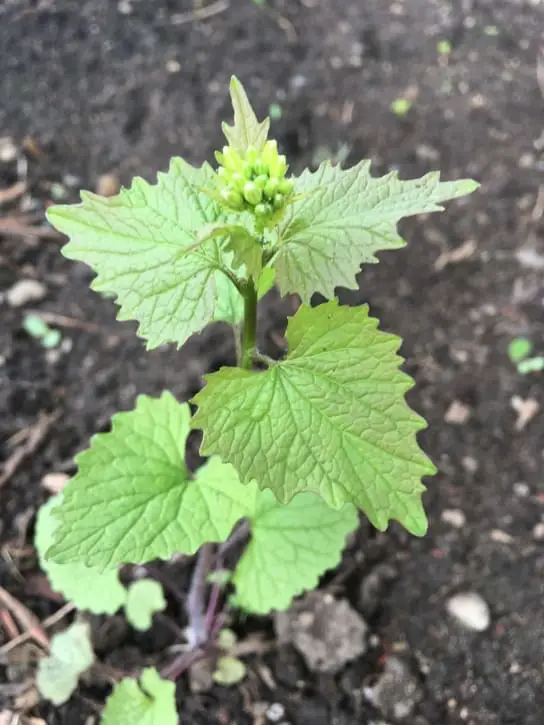
WHAT’S GARLIC MUSTARD?
If you’re new to foraging, garlic mustard is an invasive plant species that was introduced to North America at the turn of the 19th century.
The European settlers valued it for its medicinal and culinary properties.
Today, it’s seen as a weed and for conservationists, one that’s threatening native species.
In forests, garlic mustard is starving native plant species by robbing them of the soil fungi they need to thrive.
This is why conservationists are starting to encourage people to pick this plant.
Some other names that it goes by include Penny Hedge, Poor Man’s Mustard, and Garlic Root.
RELATED: Wild dandelion salad
RELATED: Putting wild violets to good use
FORAGING FOR GARLIC MUSTARD VIDEO
Watch me forage in my backyard for early spring garlic mustard. Next, I painstakingly clean my hard-earned prizes and turn them into garlic mustard pesto and horseradish. If you’re new to the Kitchen and like what you see, be sure to subscribe to my YouTube channel!
This post may contain affiliate links, meaning that if you choose to purchase something after clicking on one of the links in this post, I may earn a small commission at no additional cost to you.
RELATED: Why everyone should forage (and beginner tips)
WHERE DOES GARLIC MUSTARD GROW?
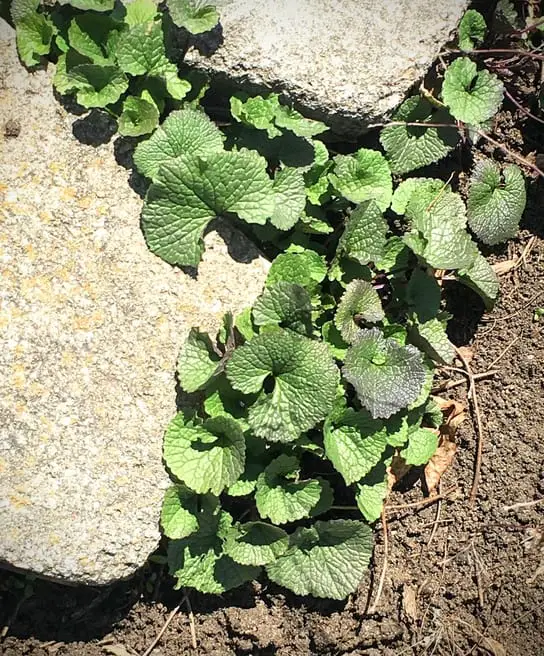
Where I am in southern Quebec, garlic mustard grows in abundance. The same holds true for Ontario.
Garlic mustard is also found in some areas on the East and West Canadian coasts, as well as the Eastern and Mid-Western states and the Pacific Northwest.
It’s taking over, I’m telling you!
This pesky, yet delicious weed thrives in busy areas, so it can often be found along hiking trails, fence lines, ditches, roadsides and in wooded areas.
In my own yard, it seems keen to grow under my spirea bushes, which means I have a heck of a time removing it.
WHAT DO I LOOK FOR WHEN FORAGING FOR GARLIC MUSTARD? ‘
I first learned about garlic mustard when I got addicted to an app called Seek by iNaturalist.
It’s like a game for nature lovers, encouraging its users to “collect” as many species as possible.
Basically, you snap photos of flora and fauna, upload them, and let recognition technology do the work.
While the app can’t always identify something, it has no problem picking out garlic mustard’s dark green scalloped leaves.
A sure way to identify garlic mustard is to rub the leaves between your fingers, gently crushing them.
If you’re on the money, a faint garlic aroma will tickle your nose.
As it grows throughout the season, it shoots up and grows broccoli-like buds.
Second-year plants produce clusters of white flowers with four petals.
Come late summer/early fall, dark brown seeds appear.
One plant can produce hundreds of seeds, which adds to the problem that forests are up against.
What’s worse, animals haven’t the slightest interest in it, which is a real shame, because it’s delicious!
Did you know that the whole plant is edible?
HOW TO USE GARLIC MUSTARD LEAVES
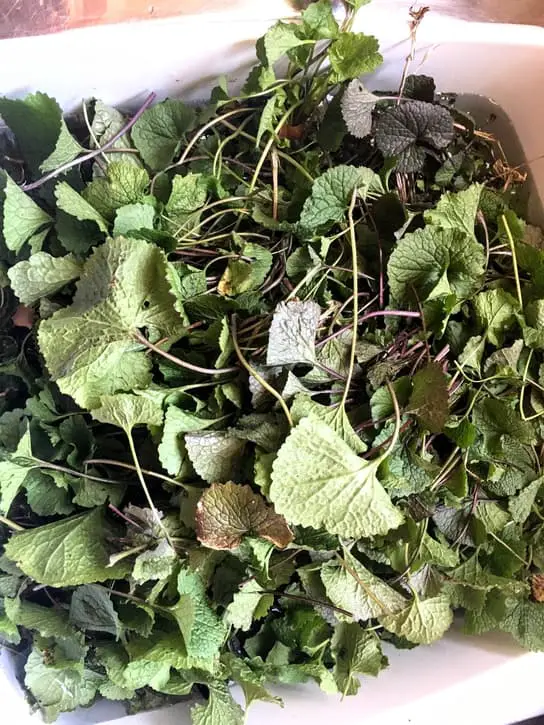
Since garlic mustard is naturally pungent, the leaves are best in early spring when they’re still mild and can be eaten raw.
For the last two years, I’ve been making pesto with my young leaves.
They’re also delicious chopped up and added to salads, just like you would with fresh parsley, mint, or coriander.
As the weather heats up and the plant matures, the leaves become more bitter.
That isn’t to say, however, that they become inedible. At this stage, the leaves can still be used.
Dehydrate them to use as a dried herb for meat rubs and homemade vinaigrettes, or sauté them like you would with spinach.
HOW TO USE GARLIC MUSTARD FLOWERS
Since I pick the garlic mustard on my property in early spring, they never reach the flowering stage.
Like calendula, nasturtium, violets and other edible flowers, garlic mustard blossoms make salads more attractive.
I don’t know about you, but I can’t help but feel fancy when I eat salads laced with flowers. It’s a fun way to dress up any appetizer, really.
HOW TO USE THE ROOT
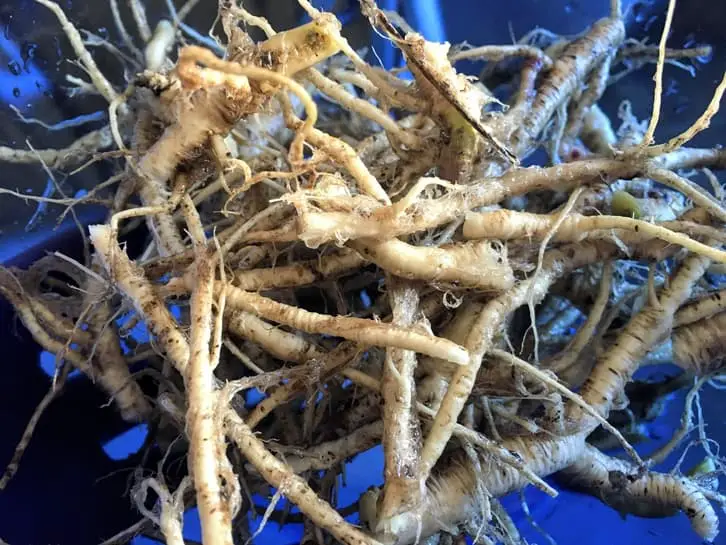
Like horseradish, garlic mustard root is quite piquant.
It’s great for making a horseradish or wasabi-like sauce!
HOW TO USE THE SEEDS
The seeds are of particular interest to me since learning that they can be used for sprouting purposes.
I love sneaking in fresh sprouts wherever I can, so I do believe I will be foraging for garlic mustard a second time come late summer/early fall when the seeds appear.
According to Leda Meredith, the author of The Forager’s Feast, the seeds can also be used to make spicy mustard.
Other areas I am interested in playing around with the seeds include grinding them up to blend into spice mixes and using them whole in meat rubs.
IMPORTANT THINGS TO KEEP IN MIND WHEN FORAGING
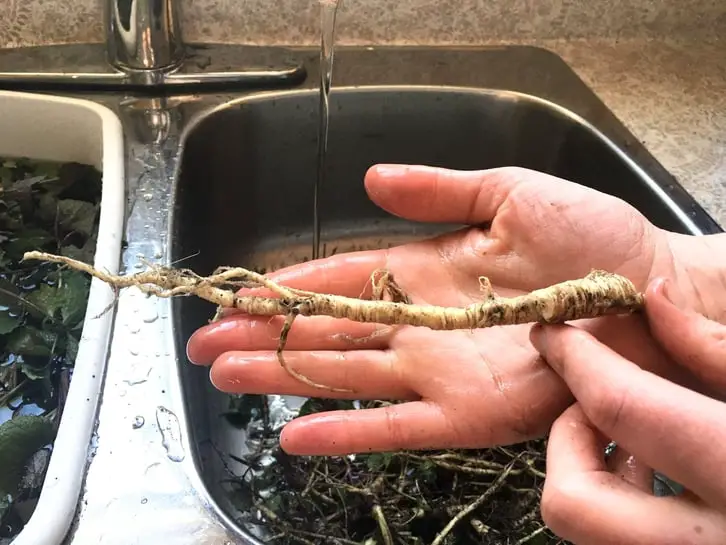
When you’re out foraging for garlic mustard, there are a few important things to bear in mind.
1. One of the ways to kill garlic mustard is to spray it with herbicide. Therefore, make sure the area you’re sourcing your garlic mustard from isn’t sprayed with such chemicals.
2. Keep an eye out for poison ivy. There are usually warning signs when there’s poison ivy nearby, so pay attention to your whereabouts.
3. Dig up the root. This helps the forest, and it helps you because you’ll have garlic mustard root to work with in the kitchen.
4. Throw out seedy plants and roots in the garbage. Composting will only help to spread the problem.
GARLIC MUSTARD HORSERADISH
Last year while harvesting my garlic mustard, I completely ignored the roots. I didn’t know they were edible!
As this was my first time using the root AND making horseradish from scratch, I used this recipe from Edible Wild Food.
In addition to the root, you will need white wine vinegar and salt. It’s beautifully simple and I couldn’t be more pleased with the results:
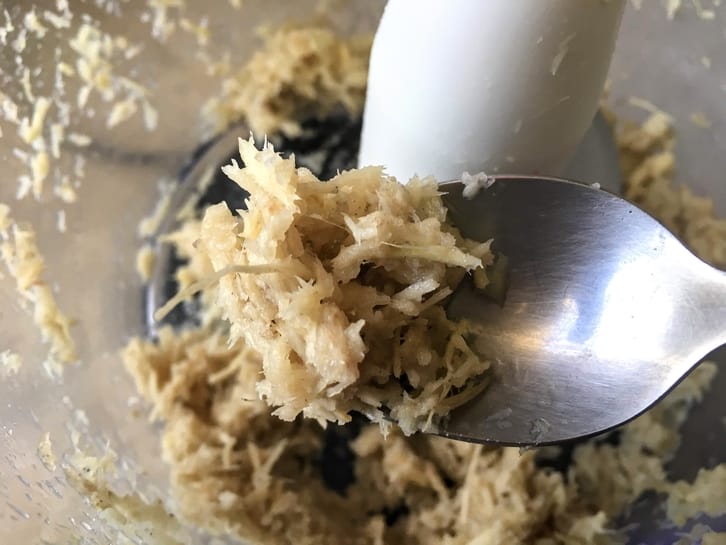
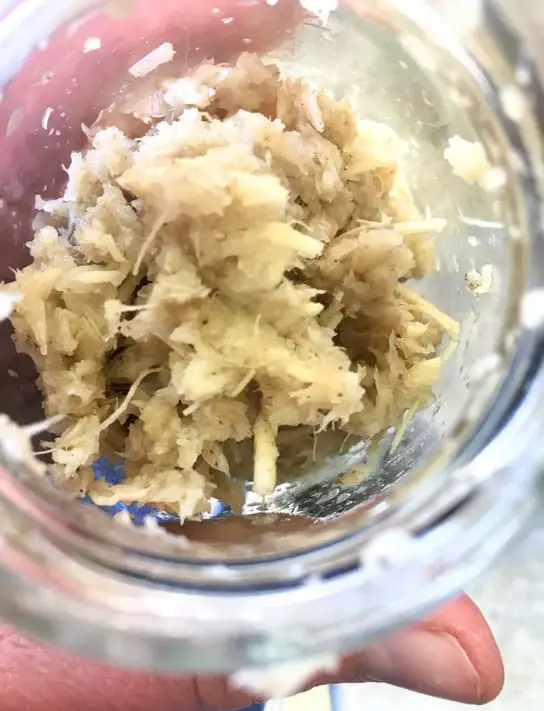
GARLIC MUSTARD PESTO RECIPE
Before any pesto purists call me out, I will begin by saying that real pesto is made with basil and pinenuts.
My garlic mustard “pesto” substitutes the basil for, well, garlic mustard, and the pinenuts for walnuts.
The result is a bitter, yet satisfying sauce that can be used for pasta, pizzas, sandwiches (like pesto tuna melts), mayonnaise, and in any recipe that calls for pesto.
THE INGREDIENTS
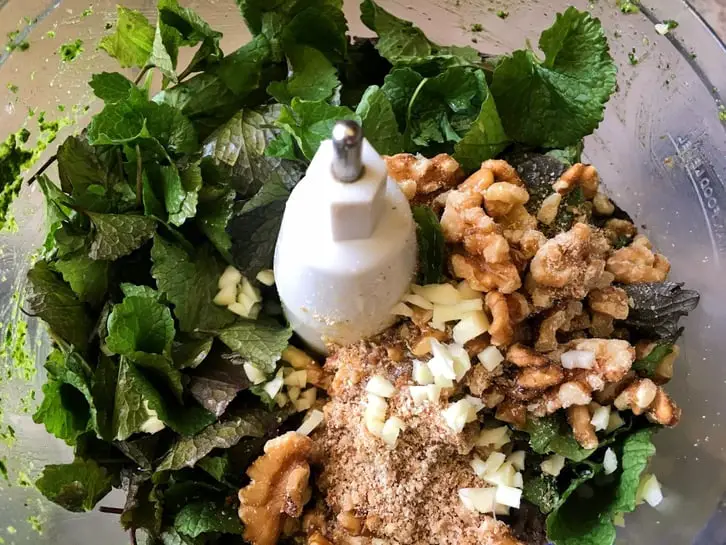
MAKES 1 CUP
2 cups garlic mustard leaves, gently packed
1 garlic clove, crushed
1/2 cup parmesan cheese, grated
1/4 cup walnuts
1/4 cup olive oil
salt and pepper to taste
THE INSTRUCTIONS
Place all of the ingredients in the bowl of a food processor.
Blend until smooth. If needed, add more olive oil, salt and pepper to taste
Refrigerate. This will keep for 3-4 weeks in the fridge.
Note: If you want to freeze the pesto, omit the parmesan as cheese doesn’t hold up well in the freezer. Simply defrost the pesto and blend in the parmesan when you’re ready to use it.
PRINTABLE GARLIC MUSTARD PESTO RECIPE CARD
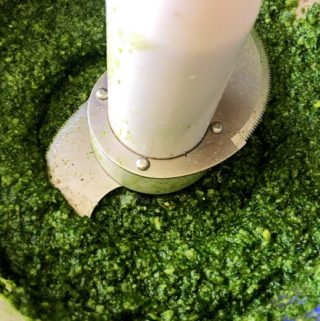
Garlic Mustard “Pesto”
Equipment
- Food Processor
Ingredients
- 2 cups garlic mustard leaves gently packed
- 1 garlic clove crushed
- 1/2 cup parmesan cheese grated
- 1/4 cup walnuts
- 1/4 cup olive oil
- salt and pepper to taste
Instructions
- Place all of the ingredients in the bowl of a food processor.
- Blend until smooth. If needed, add more olive oil, salt and pepper to taste
- Refrigerate. This will keep for 3-4 weeks in the fridge.
Notes
THANK YOU FOR POPPING BY THE KITCHEN!
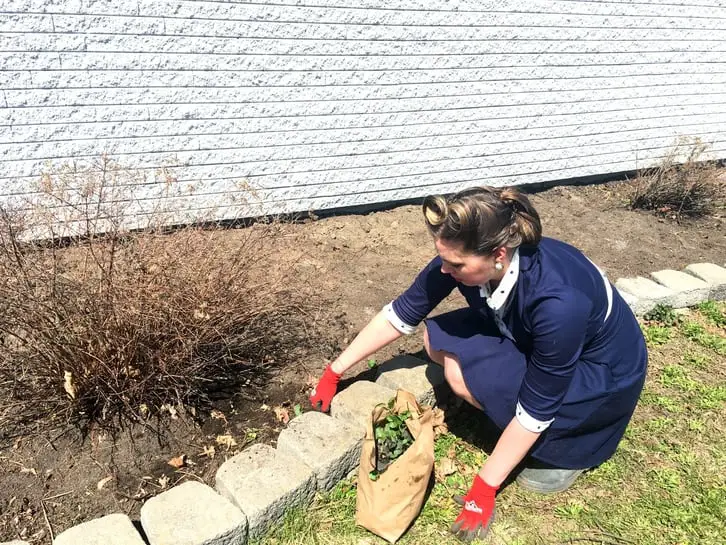
With all that being said, I hope you now have enough confidence to go forth and harvest garlic mustard!
Again, I really recommend Seek by iNaturalist to help you along the way as you get started in your foraging adventures.
If you’re new to the world of foraging, I also have an article full of foraging tips for beginners.
Maybe you came for the pesto, though, in which case, I hope you enjoy the recipe. Please let me know your thoughts in the comments below!
PIN IT FOR LATER
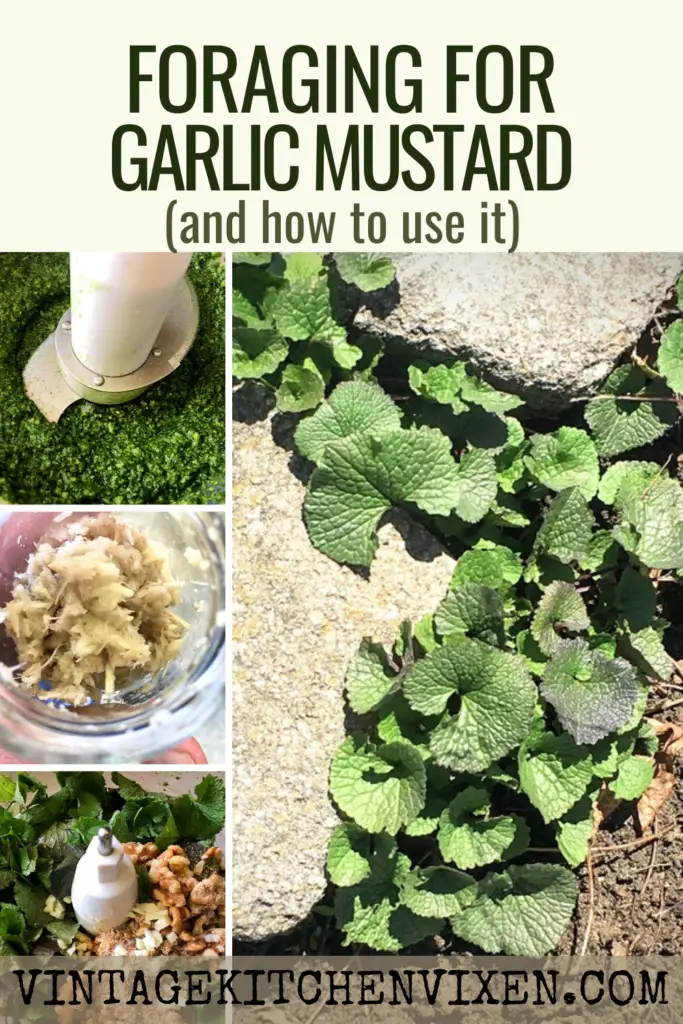
Love and gratitude,


This is such an awesome article! Thank you! I’m so excited to look for this plant, as we are moving to Alberta soon.
I’m not sure if it’s in Alberta, but if it is, happy hunting!
So interesting, Sylvia! Thank you for sharing. I’m on the lookout now.
Thank you for reading, Amy!
Oh my goodness!! I know I have some of this around my yard! I’m going to have to check out that app! Thanks for all the info!
It’s a wonderful app. Happy foraging!
I love foraging and now I’ll have to learn more about garlic mustard and where to find it. Thank you for the education and inspiration!
Excellent article except it lacks information about cyanide in older garlic mustard plants. The young plants are the good ones.
Thank you for pointing that out, Chris!